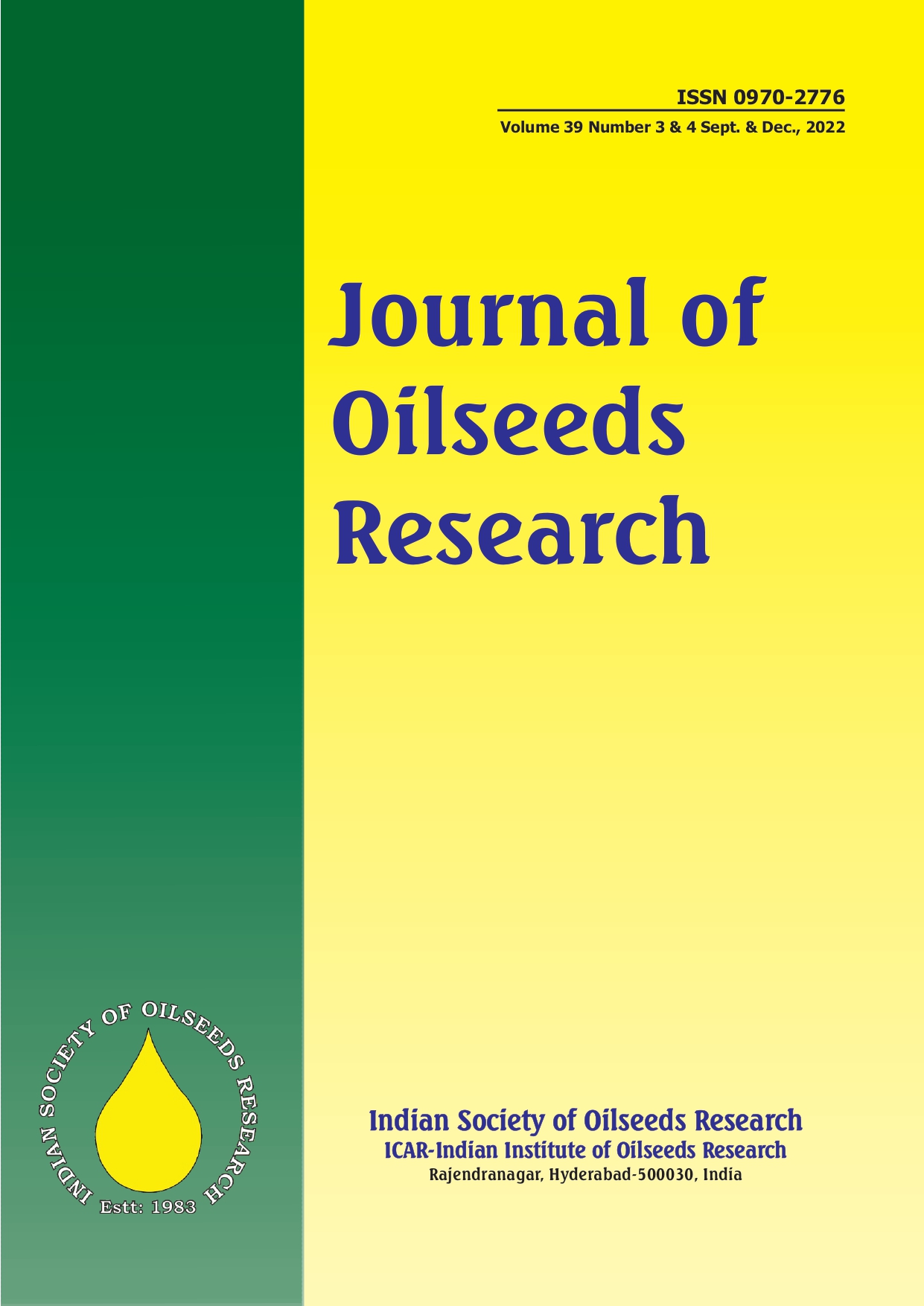Assessment of genetic variation for herbicide tolerance in sesame (Sesamum indicum L.) germplasm
ASSESSMENT OF GENETIC VARIATION FOR HERBICIDE TOLERANCE IN SESAME GERMPLASM
234 / 3
Keywords:
Genetic variation, Herbicide tolerance, Imazethpyr, SesameAbstract
To assess genetic variation for herbicide tolerance in sesame, a set of 55 genotypes were sprayed with imazethapyr@75g ai/ha on the 18th day after sowing at seedling stage. A control plot without herbicide spray was maintained. The injury caused due to Imazethapyr spray was recorded visually on 1-5 scale and the survival rate was calculated on 7th, 10th, 13thand 15th day after treatment. The herbicide injury rating ranged from 2-4.8 on 7thday after herbicide spray (DAHS) and 3.7 -5.0 on the 15th DAHS. The survival rate progressively decreased from 7th DAHS to 15th DAHS inmost genotypes. The genotype, NIC-8261 was the most sensitive genotype expressing the symptoms of herbicide injury at a very early stage. On the 15th DAHS, only 10 genotypes viz., CO-1, OTS-2, SI-328, SI-3171, NIC-16106, G-53, SI-1769, TC-25, RT-146 and NIC-8317 had a survival rate ranging from27% to 39%. The subset of 10 genotypes was further evaluated for growth and yield attributes to assess the effect of imazethapyr spray on them. Imazethapyr spray resulted in delayed flowering and adversely caused a reduction in plant height, number of capsules per plant, seeds per capsule, thousand seed weight and seed yield per plant in the sesame genotypes. The findings of the study indicated that Imazethapyr@75gai/ha applied as a post-emergence herbicide at seedling stage was toxic to sesame and caused adverse effects on sesame growth and yield, by reducing the plant height, capsule production, thousand seed weight and also caused a delay in flowering. The response of sesame genotypes to Imazethapyr application was variable suggesting that genetic variability exists for herbicide tolerance in the germplasm, which need to be studied intensively.
Downloads
References
Balyan R, Kumar S, Malik R, and Panwar R 1993. Post-emergence efficacy of atrazine in controlling weeds in pearl-millet. Indian Journal of Weed Science, 25:7-11.
Gaston S, Zabalza A, González E M, Arrese-Igor C, Aparicio-Tejo P M and Royuela M 2002. Imazethapyr, an inhibitor of the branched-chain amino acid biosynthesis, induces aerobic fermentation in pea plants. Physiologia Plantarum, 114 (4): 524-532.
Gaur P M, Jukanti A K, Samineni S, Chaturvedi S K, Singh S, Tripathi S, Singh I, Singh G, Das T K and Aski M 2013. Large genetic variability in chickpea for tolerance to herbicides imazethapyr and metribuzin. Agronomy, 3(3): 524-536.
Grichar W J, Sestak D C, Brewer K D, Besler B A, Stichler C R and Smith D T 2001a. Sesame (Sesamum indicum L.) tolerance and weed control with soil-applied herbicides. Crop Protection, 20(5): 389-394.
Grichar W J, Sestak D C, Brewer K D, Besler B A, Stichler C R and Smith D T 2001b. Sesame (Sesamum indicum L.) tolerance with various post-emergence herbicides. Crop Protection, 20(8): 685-689.
Grichar W J, Dotray PA and Langham D R 2009. Sesame (Sesamum indicum L.) response to pre-emergence herbicides. Crop Protection, 28(11): 928-933.
Grichar W J, DotrayP A and LanghamD R 2011.Weed control and the use of herbicides in sesame production, herbicides, theory and applications, MarceloLarramendy (Ed.),InTech,Available from: http://www.intechopen.com/ books/ herbicides-theoryandapplications/weed-control-and-the-use-of-herbicides-in-s esame-production.
Hanson B D and Thill DC 2001. Effects of imazethapyr and pendimethalin on lentil (Lens culinaris), pea (Pisum sativum), and a subsequent winter wheat (Triticum aestivum) crop. Weed Technology, 15(1):190-194.
IPGRI and NBPGR 2004. Descriptors for sesame (Sesamum spp.). International Plant Genetic Resources Institute, Rome, Italy, National Bureau of Plant Genetic Resources, New Delhi, India.
Maalouf F, Patil S B, Rajendra K, Hamwieh A, Goyal A and Kumar S 2016.Breeding for post emergence herbicides in cool season food legumes.Amman, Jordan: International Center for Agricultural Research in the Dry Areas (ICARDA).
Martin C. 1995. Development of an effective weed control system for sesame in the Northern Territory. Proceedings of Sesame Workshop, Darwin and Katherine, New Territory.
Rajitha D, Srikanth T, Padmaja D and Kiran Babu T 2021. Genetic variability and heritability studies among genotypes of sesame (Sesamum indicum L.). Journal of Oilseeds Research, 38(1) : 43-48,
Royuela M, Gonzalez A, Gonzalez E M, Arrese-Igor C, Aparicio-Tejo P M and Gonzalez-Murua C 2000.Physiological consequences of continuous, sublethal imazethapyr supply to pea plants. Journal of Plant Physiology, 157(3): 345-354.
Sharma S R, Singh S, Aggarwal N, Kaur J, Gill R K, Kushwah A, Patil S B and Kumar S. 2018. Genetic variation for tolerance to post-emergence herbicide, imazethapyrin lentil (Lens culinaris Medik.). Archives of Agronomy and Soil Science, 64(13): 1818-1830.
Singh A, Bisen R and Tiwari A 2018. Genetic variability and character association in sesame (Sesamum indicum L.) genotypes. International Journal of Current Microbiology and Applied Sciences, 7(11): 2407-2415.
Singh D, Dagar J and Gangwar B 1992. Investation by weeds and their management in oilseed crops. Agricultural Reviews, 13(3): 163-175.
Smith A 1989. Degradation, fate, and persistence of phenoxyalkanoic acid herbicides in soil. Reviews of Weed Science, 4: 1-24.
Tan S, Evans R R, Dahmer M L, Singh B K and Shaner D L 2005. Imidazolinone tolerant crops: history, current status and future. Pest Management Science, 61(3): 246-257.
Taran B, Holm F and Banniza S 2013. Response of chickpea cultivars to pre-and post-emergence herbicide applications. Canadian Journal of Plant Science, 93(2): 279-286.
